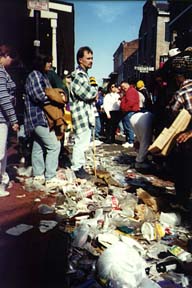
Disciplined sweeper teams perform precision drill maneuvers to keep up with the chaos.
by Ranger Kidwell-Ross
It was the last full day of the National Pavement Exposition in Atlanta when I heard that the following day would mark the beginning of Mardi Gras' final weekend. Several contractors were sitting in one of the convention center conference rooms trying to convince each other to get a rental car and make the 10 hour drive to what has been described as 'America's ultimate party.'
Over the next few hours, I couldn't stop thinking about the idea. I already had an unlimited mileage rental car I'd brought down from Nashville, I'd never been to Mardi Gras - and I just knew there'd be a sweeping story of gigantic proportions there waiting for me.
Before I knew it, all the pieces started falling into place. "It's only about 70 miles from New Orleans out to our place near Baton Rouge," offered Warren and Brigette Burge of Clean Sweep. "Why don't you drive over and stay with us?" Another sweeping contractor, Jeff Glover, offered to put me up at his house in Tuscaloosa County, Alabama, halfway point of the drive down. It even looked as though Eric Hansen, owner of Central Sweeping, in Minnesota, would be able to go along.
Next day, Saturday, the NPE officially wrapped up at noon. At the last minute, family responsibilities required that Eric take a plane back home instead. It was a little after 4 when I finally got on the road behind Jeff, and we took off at the speed of a man who's headed home to his family and his business after being gone almost a week. Jeff's wife, April, and their two boys were waiting for him to get home so they could head out for a long-planned overnight at a friend's cabin. A few minutes after our arrival, and after setting the alarm for my 5 am departure, they took off, leaving me alone in their house. Next morning, the early alarm was soon offset by a drive into the land of the bayou that I won't ever forget.
When I arrived in downtown New Orleans at 9am (the Burges had told me I needed to be there by then so I could still get a parking space), there were remarkably few clues to the magnitude of the party that had taken place there the previous day. Except for the portable grandstands positioned along several streets, a long row of porta-potties on a side street, and some sparsely scattered litter here and there, everything looked like a well cared for southern city on a Sunday morning. Over the next hour, however, all that changed at the rate of an incoming tide racing up a narrow inlet.
When the first parades, Okeanos and Thoth, started at eleven, I naively thought the streets were packed. At one thirty that afternoon, when the Mid-City parade started, what I had previously considered a crowd had at least doubled in size. By evening, when the major Bacchus parade took place, the area was crowded enough to make a sardine claustrophobic. People were jammed together shoulder-to-shoulder in wild revelry. Most seemed to be eating, drinking - and throwing all their wrappers, bottles and cans onto the ground.
Unlike other parade traditions, the Mardi Gras parades, themselves, also contribute to the immense volume of litter. A typical parade consists of 15 to 25 floats. These are very elaborately built, are from 15 to 30 feet high, and accommodate 20 to 50 riders - all of whom are throwing strings of beads and other trinkets, non-stop, throughout the parade route. Because the ground becomes so littered with thrown items which break when they hit the ground, onlookers are much more likely to think nothing of adding their trash to the pile.
New Orleans' Department of Sanitation, the agency which oversees sweeping, is quite small by big city standards. They have a total of about 30 employees, including administrative personnel. One reason they can get by with this relatively small force is because the city contracts with BFI, Inc., for their street sweeping services. According to the head of New Orlean's Sanitation Department, Sharon CarrHarrington, her department more than quadruples in size for the two week Mardi Gras event.
"We tap the public works and recreation agencies for as many support personnel and laborers as they have available," said CarrHarrington. "Fortunately, many of these folks have been working on Mardi Gras for most of their careers - up to 25 years - so it's not a new exercise to them. Of course, each year we do have some new employees, too. We have an organizational meeting two or three weeks before Mardi Gras to see that every agency is assigned to a particular designated area along the parade grounds."
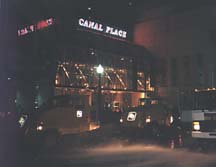
The situation is further compounded because the Mardi Gras season crams 21 downtown area parades into an eleven day time period. "There are days when we have as many as four to six parades," said CarrHarrington. "Another complication is that New Orleans is divided by the Mississippi River, and we sometimes have parades that are running concurrently on the east side of the city as well as across the river on the west side. In those situations, we have to work with BFI to get two sets of sweeper caravans set up.
"The first week of our parades, I'd say a small crowd at one would be 10,000. One of the major parades, like Bacchus or Endymion, can draw in excess of half a million people. Well over a million visitors pass through town over a two week period. There are also a lot of ancillary things going on. The French Quarter is jam packed and the suburbs are doing their own parades, too. As you might imagine, all our municipal services are being used to their capacity.
We're working with 200 - 300 laborers along a six mile
parade route.
"The typical route [for the five major parades] is about six miles, and they each take around four hours. We're working with up to 200-300 laborers along that six mile parade route. The sweepers and support equipment line up right behind the last float at the staging area. The goal is once the last float pulls out, it's clean-up time. We work very closely with the police department to clear away the crowds to get the job done. We usually have each part of the route cleaned within two hours of the time the last float leaves. Keep in mind we're talking about a six-mile stretch.
"During Christmas 1996, I was reading in the New York Times about their New Year's Eve celebration in Times Square. The article related that they had this really well-machined sanitation crew that came in to Times Square and collected about 30 tons of trash and debris from that one night of celebration. I couldn't help comparing that to the 50-100 tons we pick up per parade. We're doing that kind of cleaning every night for eleven days with 50-100% more trash! Another part of our challenge is that residents demand we return the city to normal within a very short period of time. On Ash Wednesday, the traditional end of Mardi Gras, in many parts of the city it's not evident that we've had 11 days of celebration."
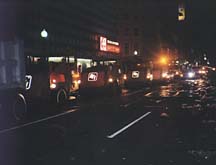
I followed the Bacchus parade on Sunday night, taking pictures and watching the highly coordinated efforts of the sweeping team in action. If sweeping can be poetry, this was it. Four Pelican 3-wheelers led the attack, with water trucks on the flanks, and a host of people hand-picking on the fringe. Dump trucks came and went constantly. Everyone looked as if they had done it many times before, which they surely had.
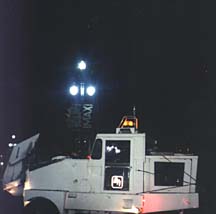
As I took photos, I no doubt presented an unusual sight, by this time decorated with an assortment of beads I had caught along the parade route. There were a few instances where workers leaned their heads into a particular pickup truck, then pointed in my general direction. When I went over to introduce myself, I found the man in charge of the actual sweeping operations, Robert Terrell, Sweeping Supervisor of BFI, Inc. In the truck with him was Richard Browning, the BFI Safety Supervisor for the cleanup. I'll never forget Browning's response when I asked to take his picture: He looked me carefully up and down, then said "Let's just wait to see if you really are who you say you are. If your story pans out, then you can take my picture." It was the voice of a man who had seen more than the usual share of unusual people. Easy to see why he was in charge of safety!
New Year's Eve in Times Square generates 30 tons of trash. We're picking up 50-100 tons every night for eleven days. And it all has to be clean by Ash Wednesday.
Organizing for Mardi Gras starts early for the BFI personnel. "We have kind of a spring training," said Terrell. "Basically, we bring in new drivers and have them do some cross-training. We bring them off their regular routes for practice, because the after-parade cleanup is a real timing thing. You have to be able to come out of your position, come up to the rear of the dump truck, dump it and be back in position within a very short period of time because we have to keep up with the parade. If we fall behind there will be all kinds of chaos because people will start filling in between us and the last float.
"If we can't keep up, the cordoned off area will fold in because people will try to close right in behind the parade and the floats. They're not interested in the clean-up procedure, and if we allow a space to open up it can easily become complete chaos. So, timing plays a big part. Each of our six dump trucks has a number, and I watch to monitor when a dump truck is full. When it is, I'll have him go and dump, and roll over into the number one spot. At the same time, the number one will go to the number six spot, and we just rotate it to keep up the pace. We just can't stop for anything.
"We have to be all over [the situation], in front of it, behind, on the side, coordinating and watching. You wouldn't believe the people who try to come in between the equipment even when we are right behind. If we were to fall behind, then you're talking a 3-4 hour lapse because, by the time the people clear out, you have the problem of all the traffic that's tied up because of the parade. And everyone would be driving through all that trash.
"The police department works very well with us to make it all happen smoothly. They have officers directing traffic at the corners, and they get out in front to create a chain wall in front of the pumper and keep the machines rolling. We also keep the dump trucks sounding their horns. We have to be mindful that some of the people out there are very intoxicated and at the same time really excited about what they've just seen - the parade and the floats.
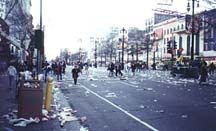
"I think the most essential advice I can offer for other sweeping managers faced with a similar type of sweeping challenge is to have your equipment properly maintained. We also make sure the drivers we have are very qualified, because a lot of times they're out there working anywhere from 13-20 hours, in fact up to 24 hours on the final day. You also don't want to over-saturate with your equipment, because then you will have debris flowing outside the curb and it will just become a big mess. The water trucks flush everything over to the side and that has a tendency to clog up the drains, too, if you haven't done a good job. You don't want to generate that problem, because then you have to either wait until the water goes down or go to the trouble of skimming it lightly to remove the debris. Either way, it turns cleanup into a long drawn-out process.
"Another big problem for us is the broken strings of beads that litter the street. There are times when we pull off anywhere from a 40-100 lb. wad of wet beads from where it is tangled around the broom. People also tend to take lightly what those brooms are made of. They think it's just like a regular nylon bristle, and they try shining their shoes and that sort of thing on them. Most people quickly realize that's not a good idea, however," he said with a chuckle.
The piles are so high, we have people out in front poking it to make sure there isn't anything that shouldn't be swept. The sweepers can only go half a block before dumping.
The French Quarter poses even more problems, due to its narrow streets and unbelievable curb line debris piles. "In the Quarter, the sweepers can only go half a block before dumping," said Terrell. "Everything but the bar stools are in the street. The debris piles are so high that we have people out in front walking and poking it, making sure there's nothing in them that shouldn't be swept. Police on horses go ahead of the equipment, and it's virtually wall-to-wall people when we start in.
"Technically, the streets like Bourbon Street are only two sweeper widths wide. We stagger one sweeper on each curb, then run another machine directly behind each of those, then one up the middle and two on each side behind that one. Debris is so thick that about every half block the lead sweepers have to dump, and as fast as we get it out of the street, the people will fill it back up because then the bars start to sweep out the doorways, etc. It's quite a sight to see, and takes a high level of coordination on everyone's part."
After seeing it for myself, I couldn't agree more. The city and BFI crews do a great job under some of the most challenging conditions imaginable. I can hardly wait to go back and have another look - as well as to see more of Mardi Gras again. Besides, I still need a picture of Richard Browning.
This article is reprinted from American Sweeper magazine, Volume 6 Number 2.
|

